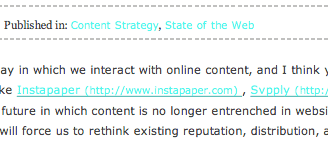Print Style Sheets and URLs
Published on Jun 14, 2011 (updated Feb 5, 2024), filed under development, css, design. (Share this on Mastodon or Bluesky?)
This and many other posts are also available as a pretty, well-behaved ebook: On Web Development.
Print style sheets are awesome. They’re easy to write, too. Site owners and developers who care about print typically know what to do. Alas there’s one thing that’s done rather the wrong than in any right way: printing URLs, typically via the content property.
Popular Mistakes
Two.
Not obtaining any data on how many users actually print out documents and go to the length of memorizing or writing down URLs they saw on the print-out to then type those URLs into the next machine they find. (There may be neither users who do that nor data to prove it.)
Displaying URLs in the wrong context, namely copy text (see the figure above). While one may maintain some optimism that URLs are actually accessed later, expanded in regular text they do but one thing—disrupt the reading flow.
In other words, don’t expand URLs in print because you can. Then, as always, exceptions prove the rule: Special forms of content like link lists, for example, can still benefit from expanding all URLs in print; important URLs may even want to be shown on screen. We just need to exercise caution.
About Me
I’m Jens (long: Jens Oliver Meiert), and I’m a web developer, manager, and author. I’ve been working as a technical lead and engineering manager for companies you’ve never heard of and companies you use every day, I’m an occasional contributor to web standards (like HTML, CSS, WCAG), and I write and review books for O’Reilly and Frontend Dogma.
I love trying things, not only in web development and engineering management, but also in other areas like philosophy. Here on meiert.com I share some of my experiences and views. (I value you being critical, interpreting charitably, and giving feedback.)

